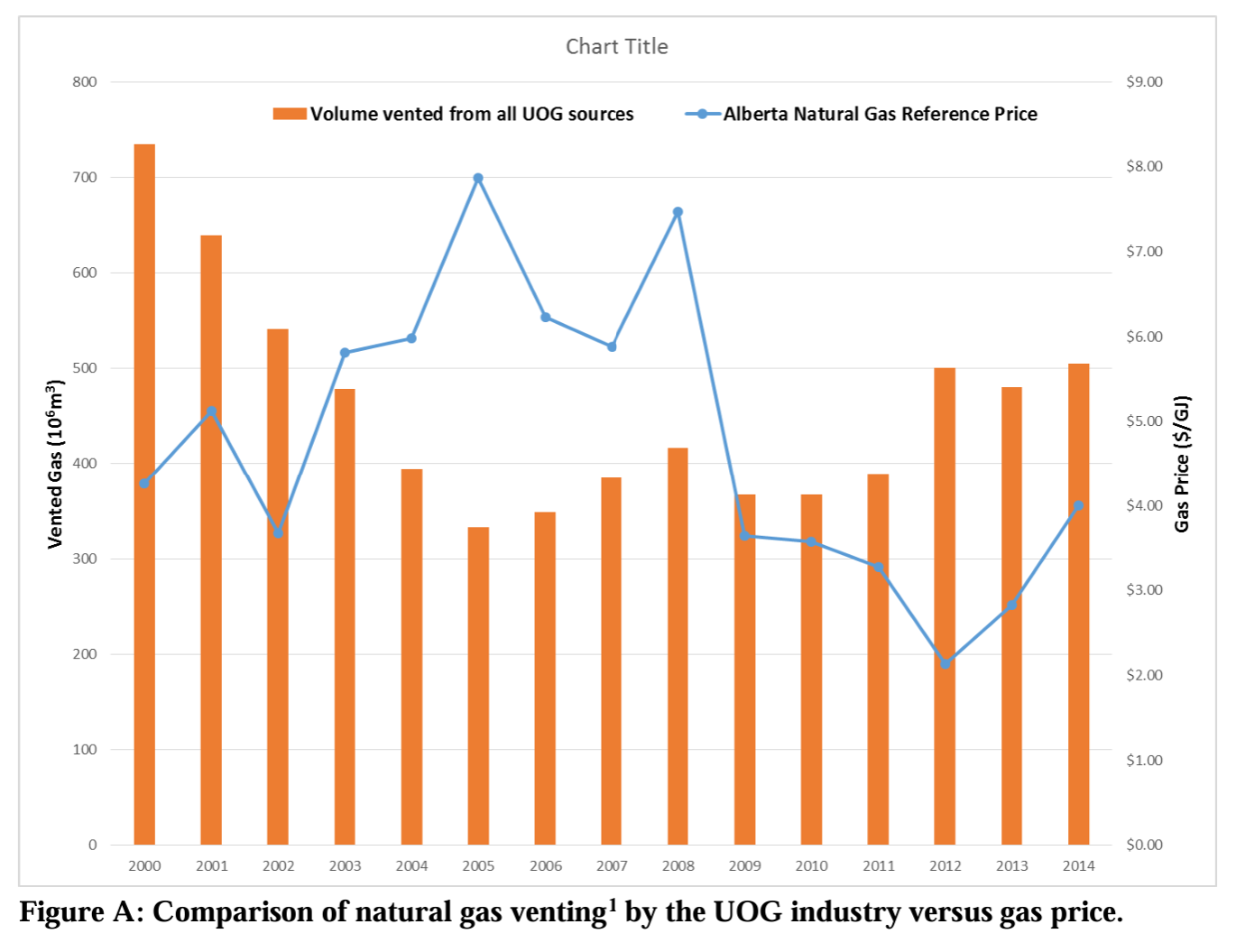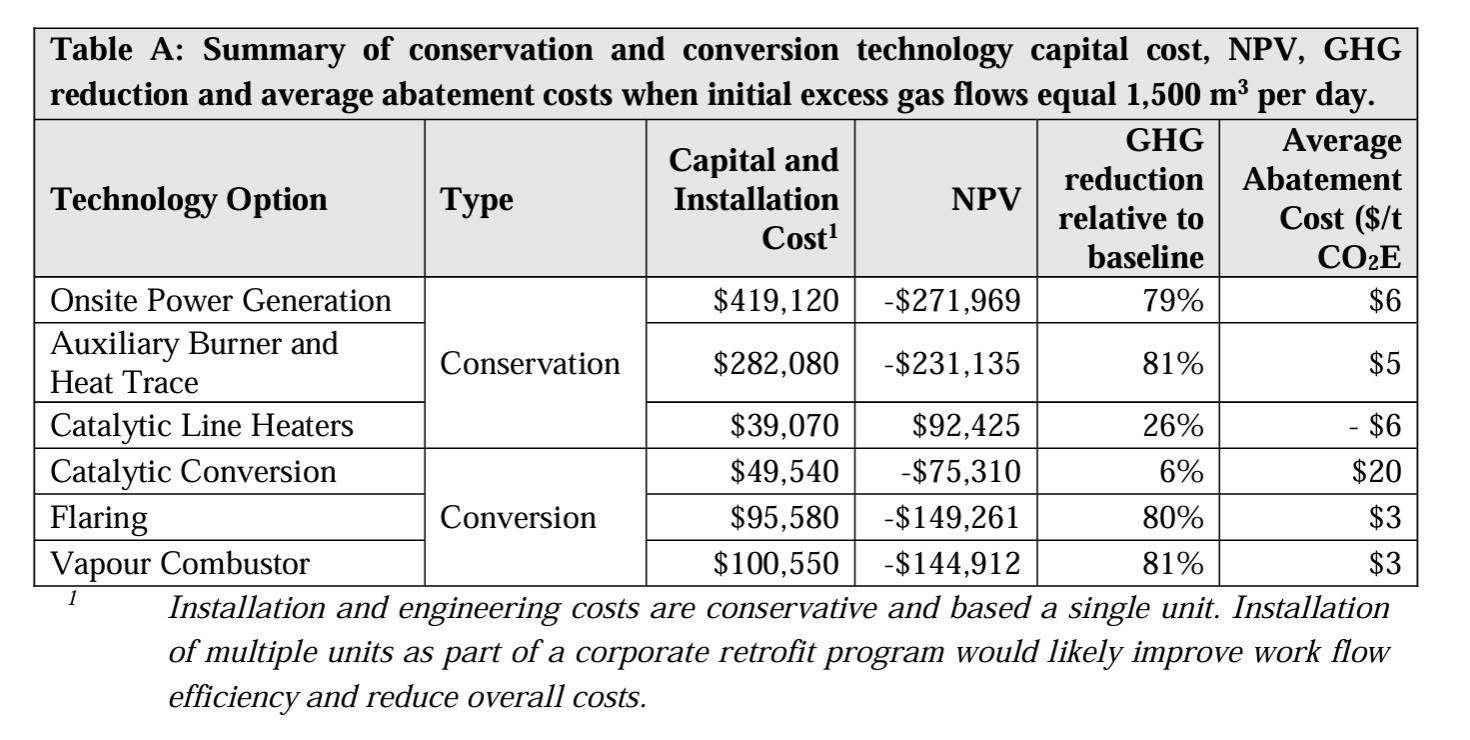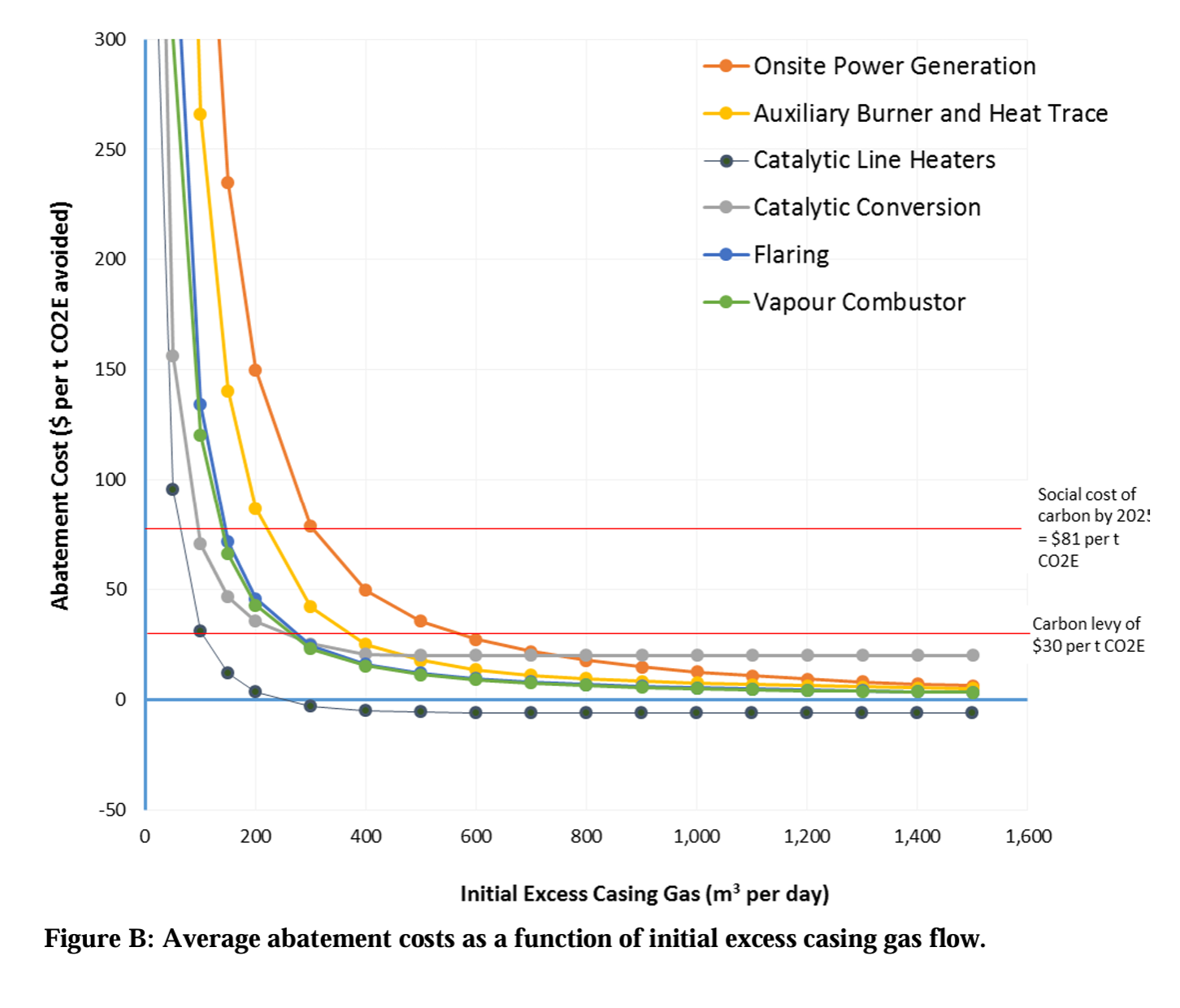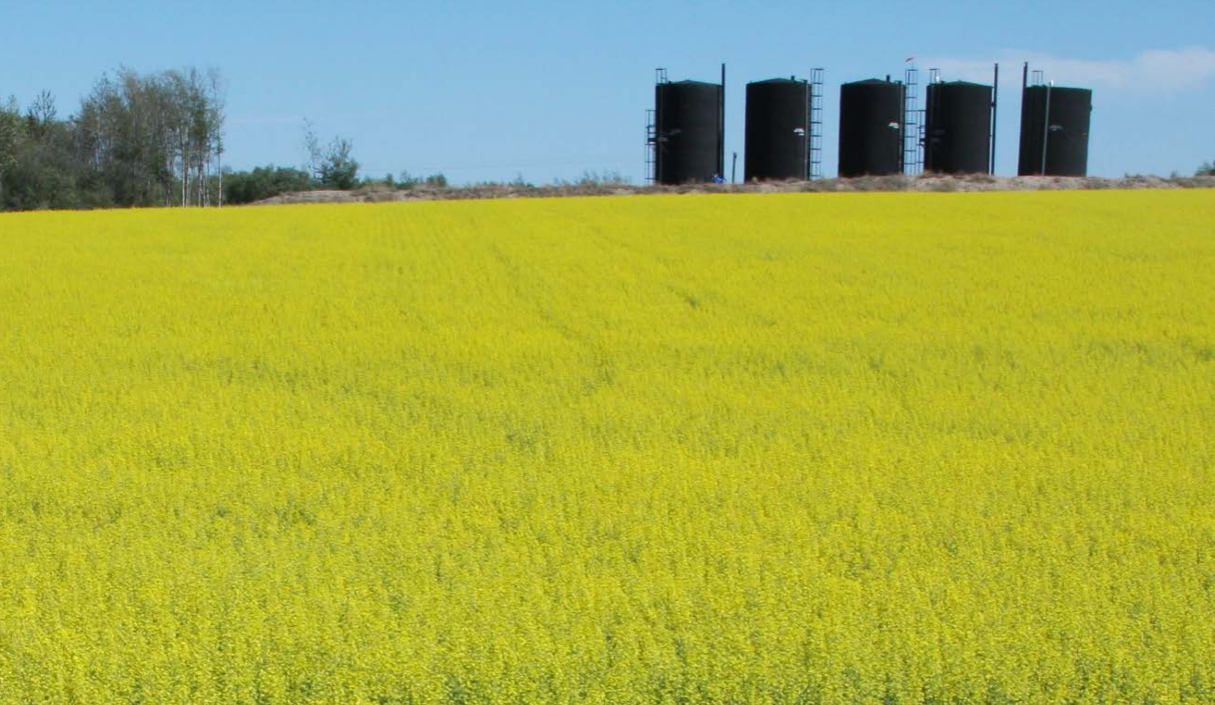Clearstone Engineering Ltd.
February 26, 2017
Executive Summary
Natural gas conservation and conversion options are evaluated at oil batteries where gas production exceeds site energy demands but is not sufficient to motivate gas gathering infrastructure. These stranded gas flows are often released directly to the atmosphere as a reliable and low cost means of disposal. When observed at isolated batteries, venting excess sweet natural gas is a safe practice that doesn’t cause offsite odours, exceed ground level ambient air quality objectives, increase lease sizes or incur landowner objections to aesthetically displeasing flare stacks. However, when aggregated together oil and bitumen battery venting is a noteworthy greenhouse gas (GHG) emission source with 8.95 megatonnes carbon dioxide (CO2) equivalent (E) released in 2011 (approximately 9 percent of direct GHG from the Canadian upstream oil and gas industry as published in Environment Canada, 2014).
Regulatory Context
Both provincial and federal regulators have endeavored to mitigate flaring and venting from the upstream oil and gas industry with limited success. In 2008, Environment Canada and provincial regulators formally endorsed the World Bank voluntary standard for global gas flaring and venting reduction (Environment Canada, 2008) with the objective to “minimize continuous and non-continuous production flaring and venting of associated gas” (World Bank, 2004). The standard provides a decision-tree process for evaluating associated gas utilization through stakeholder engagement and broadening of the project boundary to include other gas sources and consumers (e.g., clustering). It also recommends financial incentives (e.g., royalty exemptions) to enhance the viability of alternatives to flaring and venting. Implementation of the voluntary standard is completed by provincial regulators. In fact, the World Bank modeled its standard on Directive 060 developed by the Alberta Energy Regulator (AER) based on recommendations from the multi-stakeholder Clean Air Strategic Alliance (CASA).
Recognizing public concerns regarding potential health, safety, and environmental impacts of flaring, the AER released the first version of Directive 060 in 1999. It included flaring and venting baselines; a flaring management framework and reduction targets; common economic assessment process for gas conservation; volume reporting requirements; and limitations on natural gas venting by the UOG industry. Subsequent versions expanded applicability of the gas conservation decision-tree to all flaring or venting sources greater than 900 m3 per day per facility and reduced the NPV threshold to negative $55,000 (AER, 2016a).
Directive 060 proved successful for reducing flaring and venting emissions in Alberta until the mid-2000s. However, the decision to conserve versus vent natural gas depends on the market value of natural gas as evidenced in Figure A. Venting volumes reported in ST60B for UOG sources (AER, 2016a) steadily decline from 2000 until 2005 when natural gas prices peak (GLJ, 2015). From 2006 to 2013, venting volumes generally increase and trend with prices, suggesting price signals have a stronger influence on conservation practices than current regulatory intent. Although Directive 060 states “Venting is not an acceptable alternative to conservation or flaring”, sweet gas venting is occurring because operators argue it is the only feasible alternative to flaring and it complies with stated limitations.

British Columbia published Flaring, Incinerating and Venting Reduction Guidelines in 2008 while Saskatchewan published Directive S-10 in 2011. Both of these documents are similar to AERs Directive 060. Little regulatory effort is focused on flaring and venting mitigation outside of Western Canada because approximately 96 percent of Canadian UOG emissions occur in BC, AB and SK (Environment Canada, 2014).
Recent climate change policy developments are motivating further regulatory action to mitigate methane emissions and natural gas venting. In December 2015, Canada endorsed the United Nations Framework Convention on Climate Change (UNFCCC) Paris Agreement to limit global warming to less than 2o C relative to pre-industrial levels with zero net anthropogenic GHG emissions by the second half of the 21st century. Details on how federal and provincial governments plan to reduce Canada’s GHG emissions by 30 percent below 2005 levels by 2030 and implications for the oil and gas industry are expected in 2016. In anticipation of the Paris Agreement, Alberta released its climate leadership plan emphasizes methane reductions for the oil and gas sector as well as policy provisions to mitigate competitiveness impacts for trade exposed sectors. Carbon pricing will apply to “on-site combustion in conventional oil and gas” (i.e., natural gas fuel consumption and flaring) starting January 1, 2023 but not to fugitive and venting emissions. Instead, a new regulatory standard for controlling fugitive emissions (i.e., leak detection and repair) and voluntary standards for controlling venting will be developed through a multi-stakeholder process beginning early 2016.
Gas venting and flaring in the United States (US) has rapidly increased from 2.58 109m3 in 2000 to 8.18 109m3 in 2014 (EIA, 2015). This is due, in part, because of the quick and intense development of tight oil formations in Texas and North Dakota, which have significant volumes of associated gas. Regulating oil and gas production in the US is primarily the responsibility of the states, however, the Environmental Protection Agency (EPA) sets national environmental standards that states and tribes enforce through their own statutes. In 2012, the EPA finalized New Source Performance Standard (NSPS) for volatile organic compounds (VOCs) for the oil and natural gas industry (US EPA, 2012). Combined with amendments proposed in 2015, NSPS require producers to conserve natural gas flow-back that occurs during oil and gas well completions. Moreover, NSPS will also require reductions from new or modified pneumatic controllers, compressors, and storage tanks at natural gas and oil well sites; gathering stations; compressor stations and processing plants. NSPS measures are proposed with the objective of reducing methane emissions from the oil and gas sector by 40 to 45 percent from 2012 levels by 2025 (US White House. 2014). A regulatory impact analysis concluded that climate benefits outweigh implementation costs of the proposed NSPS rule (EPA, 2015a). Climate benefits were monetized by incorporating the social cost of methane that accounts for a number of anticipated climate impacts, including: human health, property damages from flood risk, agricultural productivity, and the value of ecosystem services.
Business Case Development
To assist industry and decision-makers determine appropriate flaring and venting thresholds for Western Canadian upstream oil and gas facilities; this study completes GHG reduction and economic assessments for the following gas conservation and conversion technology options. Equipment is sized for excess casing gas flows of 1,500 m3 per day or less because it is estimated 50 percent of Alberta casing gas is vented from such sites (Johnson and Coderre, 2012).
A representative, 2-well, Cold Heavy Oil Production with Sand (CHOPS) battery with the same casing gas flow rates, compositions and economic conditions was selected to provide a common basis for comparison. Net GHG emission reductions are assessed as the difference between baseline and project emissions achieved by each technology scenario. NPVs are calculated in compliance with AER Directive 060 instructions with sensitivity tests for upper and lower bound estimates of key parameters.
Results
A business case exists for the technology option when NPV is greater than zero and an investor can expect to recover their invested capital and earn a nominal rate of return. As shown in Table A, all options except catalytic line heaters, have a negative NPV under base-case conditions and would not normally be implemented because there is no economic benefit to facility owners. Average abatement costs (in present value terms) are also presented to show the total lifecycle cost incurred by an operator (net of any revenue) to avoid the release of one tonne of CO2E.

Of particular note, is that all options are highly sensitive to pricing the GHG emission savings. Figure B shows the average abatement cost varies with the volume of excess casing gas initially available. For example, if a policy was implemented whereby a levy of $30 per t CO2E was charged on venting emissions, the vapour combustor would be economic at sites with initial excess casing gas flow rates greater than 252 m3 per day while all technologies would be economic for initial flows greater than 561 m3 per day. Alternatively, if a performance standard was set on the basis of the social cost of carbon in 20252 ($81/t CO2E), the vapour combustor would be economic at sites with an initial excess casing gas flow rate greater than 132 m3 per day while all technologies would be economic for initial flows greater than 321 m3 per day.

Conclusions
For many bitumen batteries with low gas flow, clustering to maximize the volume of casing gas available can produce positive conservation economics. However, if clustering isn’t possible, the following observations for low-flow wells should be considered.
Catalytic line heaters have a positive base-case NPV and could be installed at sites where yearround casing gas use is indeed achieved by heat-tracing gas lines. Moreover, many sites have enough waste heat from existing pump engines that coolant loops could be used for heat tracing instead of additional line heaters. In these cases, battery operating costs and GHG emissions can be reduced for very little capital investment.
Conserving excess casing gas for small-scale, decentralized, electricity generation may be an important contribution to base-load power in Alberta as coal-fired power plants are phased out over the next 15 years. In cases where distribution lines are within 480 meters of the site and have sufficient capacity for the incremental power supply, base-case NPV is greater than the Directive 060 threshold requiring conservation projects to proceed. Moreover, monetization of carbon (in the range of $10 per t CO2E) can swing the decision for sites to produce power if initial excess gas flows are above 1,300 m3 per day. However, the decision also depends on whether site-specific casing gas flows are predictable over the eight year project life.
Installing auxiliary burners in tank heater stacks is an innovative approach to managing excess casing gas that minimizes impact to site lease sizes, traffic patterns and visual aesthetics. The burners respond well to variable gas flows from 0 up to 21 m3 per hour per unit and produce heat for freeze protecting gas lines during cold months. Monetization of carbon (in the range of $10 per t CO2E) can swing the decision for sites to install auxiliary burners if initial excess gas flows are above 900 m3 per day. However, installation of a glycol exchanger and pump for heat-tracing may prove difficult and better accomplished with catalytic line heaters or excess heat from engine coolant loops.
When choosing a conversion technology because no conservation opportunities are available, consider that a flare will dispose much larger flows than a vapour combustor (i.e., max for a single combustor is 1,500 m3 per day). Moreover, the average abatement cost for a flare decreases as flow rates increase while abatement costs remains relatively static for the vapour combustor. For example, the average abatement cost for a flare would be $0.49 per t CO2E avoided and $2.26 per t CO2E for the vapour combustor if initial flow increased to 10,000 m3 per day. However, it’s difficult for flares to maintain stable combustion at exit velocities less than 1 m/s (e.g., 680 m3 per day or less for a 4” diameter flare tip).
Vapour combustors are recommended for converting gas flows less than 1,500 m3 per day because they result in the greatest GHG reduction for the lowest average abatement cost. Moreover, they are specifically designed for intermittent flows typical of many CHOPS batteries.

# 15-ARPC-07